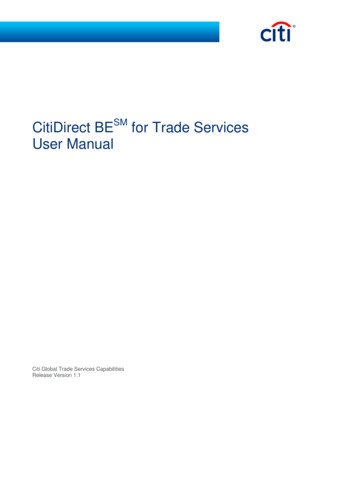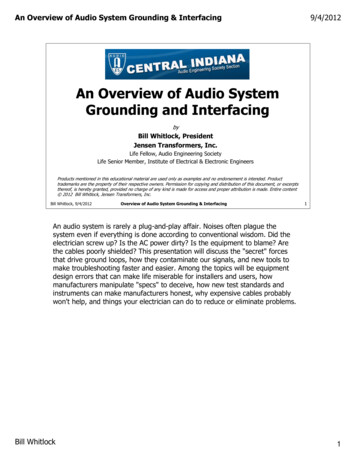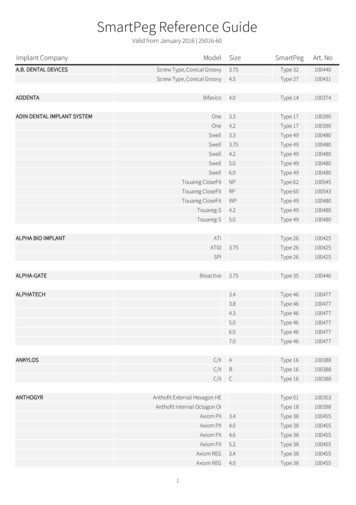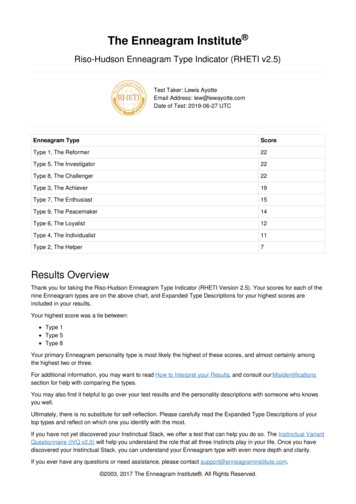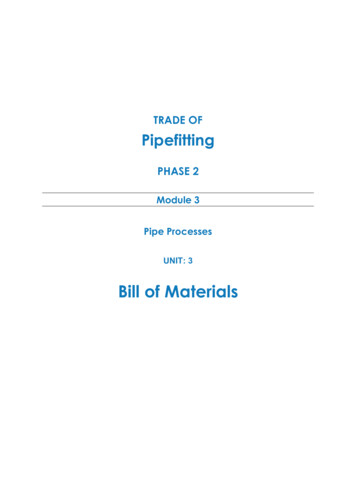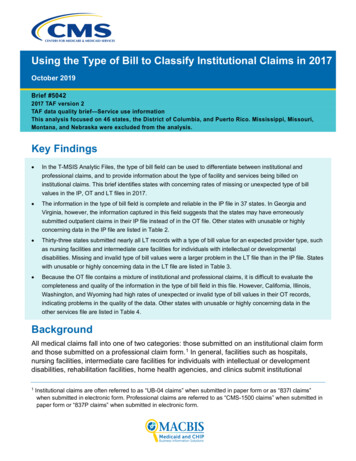
Transcription
Using the Type of Bill to Classify Institutional Claims in 2017October 2019Brief #50422017 TAF version 2TAF data quality brief—Service use informationThis analysis focused on 46 states, the District of Columbia, and Puerto Rico. Mississippi, Missouri,Montana, and Nebraska were excluded from the analysis.Key Findings In the T-MSIS Analytic Files, the type of bill field can be used to differentiate between institutional andprofessional claims, and to provide information about the type of facility and services being billed oninstitutional claims. This brief identifies states with concerning rates of missing or unexpected type of billvalues in the IP, OT and LT files in 2017. The information in the type of bill field is complete and reliable in the IP file in 37 states. In Georgia andVirginia, however, the information captured in this field suggests that the states may have erroneouslysubmitted outpatient claims in their IP file instead of in the OT file. Other states with unusable or highlyconcerning data in the IP file are listed in Table 2. Thirty-three states submitted nearly all LT records with a type of bill value for an expected provider type, suchas nursing facilities and intermediate care facilities for individuals with intellectual or developmentaldisabilities. Missing and invalid type of bill values were a larger problem in the LT file than in the IP file. Stateswith unusable or highly concerning data in the LT file are listed in Table 3. Because the OT file contains a mixture of institutional and professional claims, it is difficult to evaluate thecompleteness and quality of the information in the type of bill field in this file. However, California, Illinois,Washington, and Wyoming had high rates of unexpected or invalid type of bill values in their OT records,indicating problems in the quality of the data. Other states with unusable or highly concerning data in theother services file are listed in Table 4.BackgroundAll medical claims fall into one of two categories: those submitted on an institutional claim formand those submitted on a professional claim form. 1 In general, facilities such as hospitals,nursing facilities, intermediate care facilities for individuals with intellectual or developmentdisabilities, rehabilitation facilities, home health agencies, and clinics submit institutional1Institutional claims are often referred to as “UB-04 claims” when submitted in paper form or as “837I claims”when submitted in electronic form. Professional claims are referred to as “CMS-1500 claims” when submitted inpaper form or “837P claims” when submitted in electronic form.
MACBIS Medicaid and CHIP Business Information Solutionsclaims. Physicians (both individual and groups), other clinical professionals, freestandinglaboratories and outpatient facilities, 2 ambulances, and durable medical equipment supplierssubmit professional claims. It is important for users of the T-MSIS Analytic Files (TAF) to beable to distinguish between institutional and professional claims, as the standardized fields ineach form—and hence the information available for each type of claim—differ slightly. Oneimportant field that is reported only on institutional claims is the type of bill. This field is used toreport the type of facility that provides care. Because the type of bill field is used by mostpayers to determine the payment amount for the claim, it is often well-populated in claims dataand is considered a reliable source of information. As a result, it is often the first and easiestdata element used to differentiate among key settings and types of institutional care, such asinpatient hospital stays, outpatient hospital visits, or nursing facility care. 3This brief examines the completeness and quality of the type of bill field in the TAF for 2017and whether the distribution of values within each medical claim file reflects the types of claimsthat states are expected to submit. 4MethodsUsing the 2017 TAF, 5 we examined the type of bill field (BILL TYPE CD) on header records inthe inpatient (IP), long-term care (LT), and other services (OT) files. Since type of bill is notcaptured on pharmacy claims, we did not examine the pharmacy (RX) file. We included in theanalysis fee-for-service (FFS) claims and managed care encounter records for both Medicaidand CHIP beneficiaries in 46 states, the District of Columbia, and Puerto Rico. 6 Mississippi,2Freestanding facilities are those not owned by a hospital or another institutional provider, such as independentambulatory surgery centers.3The national provider identifier or provider taxonomy can be used to differentiate among most settings of care,such as nursing facilities versus hospitals, but it requires outside data that can map a large number of potentialvalues to provider type. As of 2017, not all states consistently reported these data elements. The revenue codecan be used to differentiate types of care, such as inpatient versus outpatient services, but it does not provideinformation about the type of institution that delivered the care. Type of service is considered less reliable, butthis field could be used when type of bill is missing or invalid.4The inpatient file should primarily include institutional claims for inpatient hospital services, whereas the longterm care file should include institutional claims for overnight stays at nursing facilities, intermediate carefacilities for individuals with intellectual or developmental disabilities, and residential treatment facilities. Theother services file should include a mix of outpatient institutional claims and professional claims from all settingsof care. We expect that a type of bill code will be populated only on institutional claims, and therefore that thetype of bill code will be missing for a large share of claims in the other services file.5This analysis used the same TAF data as the T-MSIS Substance Use Disorder Data Book, which is not theversion of the data that will be released as TAF Research Identifiable Files (RIFs).6Claim type code (CLM TYPE CD) was used to determine which records to include and exclude. FFS records(claim type 1 or A) and managed care encounters (3 and C) were retained in the analysis. We excluded recordswith all other claim type values, including capitation payments, service tracking claims, and supplementalpayments, none of which are expected to have a valid type of bill value since they are financial transactionrecords that are not submitted on an institutional claim form. We also excluded the “other” records that the statedid not classify as either Medicaid or CHIP payment records; these may represent services that do not qualifyfor federal matching funds under Title XIX or Title XXI.TAF DQ BRIEF #50422
MACBIS Medicaid and CHIP Business Information SolutionsMissouri, Montana, and Nebraska were excluded from the analyses because of a very lowvolume of claims.On institutional claims, the type of bill should always be formatted as a four-digit number thatstarts with a zero. 7 The second and third digits can be used to identify the type of service andfacility associated with the claim. The fourth digit provides information about the relationship ofthe claim to other claims for the same stay; for example, whether the claim covers the entirestay from admission through discharge, or whether it is a continuation claim for a stay that hasalready been partly billed. 8 For this analysis, we focused only on the second and third digitsand allowed any value in the fourth position. We grouped each of the possible 55 values forthe second and third digits in the type of bill into those that are expected or unexpected in eachfile (Table 1). We also tabulated the extent of missing and invalid values.Table 1. Mapping of type of bill values to expected file locationValueDescriptionExpectedvalue inIP fileExpectedvalue inOT fileExpectedvalue inLT file011x-012xInpatient hospitalYes013x-014xOutpatient hospital015x-018xHospital intermediate care and swing bedsYes021x-022xNursing facilities - inpatientYes023x-024xNursing facilities - outpatient025x-028xNursing facilities - intermediate care, swing beds031x-038xHome health041x-042xReligious nonmedical hospital - inpatient043x-044xReligious nonmedical hospital - outpatient045x-048xReligious nonmedical hospital - intermediate care, swing bedsYes061x-068xIntermediate care facilitiesYes071x-079xClinicsYes081x-084xOther special facilitiesYes085xCritical access hospital086xResidential facilityYesYes089xOther special facilityYesYesYesYesYesYesYesYesYesYesSource: TAF Data Dictionary.We considered states where more than 90 percent of header records were reported with avalid type of bill code that was expected for the file type to present a low level of concern. We7Appendix IP-3 in the TAF inpatient data dictionary includes a list of valid values for the second, third, and fourthdigits in the type of bill field, and a description of each possible value.8There is some variation across states in the coding of the type of bill field. In some states, most or all recordshad a type of bill value that was three digits long because the leading zero was dropped. We considered thesethree-digit values to be valid as long as they matched to a valid value once a leading zero was added. We didnot consider type of bill codes of one or two digits, or three digits with a leading zero (i.e., missing a fourth digit)as valid.TAF DQ BRIEF #50423
MACBIS Medicaid and CHIP Business Information Solutionscategorized those states where 80 to 90 percent of header records were reported with anexpected code as medium data quality concern, and states where only 50 to 80 percent ofheader records were reported with an expected code as high data quality concern for the typeof bill field. In the IP and LT files, states where more than 50 percent of header records had atype of bill code that was invalid, missing, or unexpected for the file type were categorized asunusable. In the OT file, where “missing” is a valid value for professional claims, data fromstates where more than 50 percent of header records had an invalid or unexpected type of billvalue were considered unusable. Additionally, data from states where 100 percent of headerrecords had a missing value for type of bill in the OT file were considered unusable.FindingsThe majority of states reported institutional claim records with a valid and expected type of billvalue. Notable exceptions are presented below, by file.IP file. The quality of the type of bill information in the IP file was high, with most recordshaving an expected type of bill value indicating inpatient hospital or other overnight facility(Figure 1; Table 2). Two states had high rates of missing values in the IP file (South Carolinaand Utah). One state (Wyoming) populated records exclusively with invalid values. 9 Two otherstates displayed an unusual pattern that suggests specific data quality issues in the IP file: More than 80 percent of the records in Georgia’s IP file had an unexpected type of bill codesuggesting that they were outpatient hospital claims, which the state confirmed it haderroneously included in its IP submission (rather than in its OT submission) in 2017. Theserecords should not be treated as inpatient stays despite their presence in the IP file. TAFusers should identify and exclude these records from analyses of inpatient hospital careusing the type of bill codes for outpatient services (‘013x’ and ‘014x’). Over 40 percent of the records in Virginia’s IP file had an unexpected type of bill value,primarily indicating clinics that are not likely to provide inpatient services. 10 It is not clearwhether these records are for outpatient services that were erroneously included in the IPfile or whether the type of bill field was incorrectly coded on inpatient claims. TAF usersshould consider removing these claims (identified by type of bill values of (‘071x’ through‘079x’) from analyses of inpatient hospital care.LT file. In 33 states, 90 percent or more of the LT records had an expected type of bill valueindicating that care was provided at a nursing facility, intermediate care facility for individualswith intellectual or developmental disabilities, or other non-acute overnight facility (Figure 2;Table 3). Three states (New Hampshire, New Jersey, and South Carolina) had high rates of9Wyoming has confirmed that their Medicaid Management Information System does not store the type of billinformation as reported on institutional claims. Although the information in the type of bill field often appears tomatch to a valid type of bill value on which both the leading zero and final digit were truncated, this pattern doesnot always hold true. As a result, users should not attempt to convert the information in the type of bill field inWyoming’s data to valid values.10The most common unexpected type of bill values observed in Virginia’s IP data were ‘77x’, indicating a federallyqualified health center; ‘72x’, indicating an end-stage renal disease clinic; ‘22x’, indicating inpatient servicesprovided at a skilled nursing facility; and ‘71x’, indicating a rural health clinic.TAF DQ BRIEF #50424
MACBIS Medicaid and CHIP Business Information Solutionsmissing values in the type of bill on LT records. Four states (Arkansas, Louisiana, New Mexico,and Wyoming) had invalid values on 10 percent or more of LT records. Five states (Alaska,California, Delaware, Massachusetts, and West Virginia) had unexpected values on more than10 percent of LT records, which may represent records reported into the wrong file ormiscoded information in the type of bill field: In four of the states (Alaska, Delaware, Massachusetts, and West Virginia), most of theunexpected type of bill values represented inpatient hospital services (‘011x’ and ‘012x’),which is an expected value in only the IP file. In Massachusetts, about a third of the unexpected type of bill values represented anoutpatient hospital (‘013x’) value, which is an expected value only in the OT file. In California, most of the unexpected type of bill values were for outpatient services at anursing facility (‘023x’ and ‘024x’).OT file. The OT file includes records for all medical services other than overnight institutionalclaims, including both institutional claims for outpatient services and professional claims. In theformer, the type of bill field should always be coded with a valid value. In the latter, the fieldshould always be blank. Because a high proportion of records in the OT file representprofessional claims, we expect high rates of missingness in the type of bill field for this file. Asexpected, we observed that between 5 and 25 percent of OT records had a non-missing typeof bill value (Figure 3; Table 4). When the type of bill information appears on an OT record, italmost always indicates an expected provider type, including hospital outpatient facility, clinic,or other outpatient facility. However, a few states have unusual patterns in the type of bill fieldthat indicate data quality problems: In Washington, 89 percent of OT records are coded with the invalid value ‘099x’, and norecords have a missing type of bill value, which we would expect to see on all professionalclaims. It is possible that the state is erroneously populating professional claims with theinvalid ‘099x’ value rather than leaving that field blank. In California, about one-third of OT records have a type of bill value that maps to aninpatient or other overnight facility stay. In addition, the proportion of OT records with amissing type of bill value is substantially lower than all other states. It is not clear whetherthe state reported overnight facility claims in the wrong file or whether the type of bill valuewas incorrectly coded on OT records. In Illinois, the type of bill field was blank on virtually all OT records. It is very unlikely thatthe state did not process any institutional outpatient claims. In Wyoming, the type of bill field was populated exclusively with missing or invalid values.TAF DQ BRIEF #50425
MACBIS Medicaid and CHIP Business Information SolutionsFigure 1. Type of bill values in the IP file, 2017Source: 2017 TAF as of January 2019.Notes: The values in the type of bill field were categorized as noted in Table 1. States are ordered based on the proportion ofheader records using a specific code that is expected for the IP file. States where more than 90 percent of headerrecords had an expected type of bill code were categorized as low data quality concern. States where 80 to 90percent of header records had an expected code were categorized as medium data quality concern, and stateswhere only 50 to 80 percent of header records had an expected code were categorized as high data quality concern.States where more than 50 percent of header records had a type of bill code that was invalid, missing, or unexpectedwere categorized as unusable. The vertical dotted black lines indicate these thresholds in the figure. The data usedfor this figure are shown in Table 2.TAF DQ BRIEF #50426
MACBIS Medicaid and CHIP Business Information SolutionsTable 2. Percentage of IP header records in each type of bill category, 2017Percentage of IP recordsStateNumber ofIP recordsExpected typeof bill codeUnexpectedtype ofbill codeInvalid valueMissingLow data quality concern (n 37 states)District of 0.00.0Maine27,731100.00.00.00.0North 0.00.00.00.0Rhode Island23,362100.00.00.00.0New 0.0West 0499.50.50.00.0New h 0.02.9Colorado129,76396.73.30.00.0New JerseySouth DakotaMassachusettsTAF DQ BRIEF #50427
MACBIS Medicaid and CHIP Business Information SolutionsTable 2 (continued)Percentage of IP recordsStateOhioKansasNew YorkExpected typeof bill codeUnexpectedtype ofbill codeInvalid 01,452,74091.11.30.07.6Number ofIP recordsMedium data quality concern (n 5 utHigh data quality concern (n 2 states)Puerto 63117.581.40.01.111,8510.00.0100.00.0Unusable type of bill code (n 4 states)UtahSouth CarolinaGeorgiaWyomingExcluded from analysis (n 4 anaDQDQDQDQDQNebraskaDQDQDQDQDQSource: 2017 TAF as of January 2019.Notes:States where more than 90 percent of header records had an expected type of bill code were categorized as low dataquality concern. States where 80 to 90 percent of header records had an expected code were categorized as mediumdata quality concern, and states where only 50 to 80 percent of header records had an expected code werecategorized as high data quality concern. States where more than 50 percent of header records had a type of billcode that was invalid, missing, or unexpected were categorized as unusable.DQ Not reported because of concerns about a low volume of claims.TAF DQ BRIEF #50428
MACBIS Medicaid and CHIP Business Information SolutionsFigure 2. Type of bill values in the LT file, 2017Source: 2017 TAF as of January 2019.Notes: The values in the type of bill field were categorized as noted in Table 1. States are ordered based on the proportion ofheader records using a specific code that is expected for the LT file. States where more than 90 percent of headerrecords had an expected type of bill code were categorized as low data quality concern. States where 80 to 90percent of header records had an expected code were categorized as medium data quality concern, and stateswhere only 50 to 80 percent of header records had an expected code were categorized as high data quality concern.States where more than 50 percent of header records had a type of bill code that was invalid, missing, or unexpectedwere categorized as unusable. These thresholds are displayed in the figure with the vertical dotted black lines. Thedata used for this figure are shown in Table 3.TAF DQ BRIEF #50429
MACBIS Medicaid and CHIP Business Information SolutionsTable 3. Percentage of LT header records in each type of bill category, 2017Percentage of LT recordsStateNumber ofLT recordsExpectedtype ofbill codeUnexpectedtype ofbill codeInvalid valueMissingLow data quality concern (n 33 0.00.1Vermont40,47499.40.60.00.0Rhode hio510,03698.91.10.00.0South 163,45498.80.70.00.51,107,22198.51.50.00.0District of 0.0Nevada78,39092.27.80.00.0WisconsinNorth CarolinaNorth DakotaTexasTAF DQ BRIEF #504210
MACBIS Medicaid and CHIP Business Information SolutionsTable 3 (continued)Percentage of LT recordsExpectedtype ofbill codeUnexpectedtype ofbill codeInvalid 0.0West 8,09684.710.84.00.479,04384.12.913.00.0StateNumber ofLT recordsMedium data quality concern (n 7 states)MassachusettsAlaskaNew MexicoHigh data quality concern (n 4 states)New 9.90.0Louisiana383,36664.58.327.20.0New Hampshire126,49252.20.30.047.5New Jersey498,55631.80.60.067.7South nusable (n 3 states)WyomingExcluded from analysis (n 5 anaDQDQDQDQDQNebraskaDQDQDQDQDQ0————Puerto RicoSource: 2017 TAF as of January 2019.Notes:States where more than 90 percent of header records had an expected type of bill code were categorized as low dataquality concern. States where 80 to 90 percent of header records had an expected code were categorized as mediumdata quality concern, and states where only 50 to 80 percent of header records had an expected code werecategorized as high data quality concern. States where more than 50 percent of header records had a type of billcode that was invalid, missing, or unexpected were categorized as unusable. Puerto Rico was not classified into anygroup because its Medicaid program does not cover institutional long-term care as a benefit and as a result it doesnot submit any records into the LT file.DQ Not reported because of concerns about a low volume of claims.TAF DQ BRIEF #504211
MACBIS Medicaid and CHIP Business Information SolutionsFigure 3. Type of bill values in the OT file, 2017Source: 2017 TAF as of January 2019.Notes: The values in the type of bill field were categorized as noted in Table 1. States where more than 90 percent of headerrecords had an expected type of bill code were considered to present a low level of concern. States where 80 to 90percent of header records had an expected code were categorized as medium data quality concern, and stateswhere only 50 to 80 percent of header records had an expected code were categorized as high data quality concernfor the type of bill field. “Missing” is a valid value for professional claims in the OT file; therefore, states with more than50 percent of header records with an invalid or unexpected type of bill were considered unusable. Additionally, stateswhere 100 percent of header records had missing type of bill in the OT file were also considered unusable; theseunexpected data patterns are indicated using red borders in the figure. The data used for this figure are shown inTable 4.TAF DQ BRIEF #504212
MACBIS Medicaid and CHIP Business Information SolutionsTable 4. Percentage of OT header records in each type of bill category, 2017Percentage of OT recordsStateNumber ofOT recordsAny expectedvalue (includingmissing)Non-missing,expected valueMissing value(expectedin OT file)UnexpectedvalueInvalid valueLow data quality concern (n 44 8.20.00.0South Carolina23,515,634100.01.798.30.00.0South de 0.0West orth 0100.010.189.90.00.0District of 0.00.0PennsylvaniaTAF DQ BRIEF #504213
MACBIS Medicaid and CHIP Business Information SolutionsTable 4 (continued)Percentage of OT recordsStateNumber ofOT recordsAny expectedvalue (includingmissing)Non-missing,expected valueMissing value(expectedin OT file)UnexpectedvalueInvalid 0Arkansas19,890,03099.98.891.10.00.0New 30.10.0New w HampshireTexasNorth DakotaMaineNew YorkPuerto RicoHigh data quality concern (n 4 a217,539,71762.538.024.534.62.9TAF DQ BRIEF #504214
MACBIS Medicaid and CHIP Business Information SolutionsTable 4 (continued)Percentage of OT recordsStateNumber ofOT recordsAny expectedvalue (includingmissing)Non-missing,expected valueMissing value(expectedin OT file)UnexpectedvalueInvalid s65,611,174100.00.0100.00.00.0Excluded from analysis (n 4 MontanaDQDQDQDQDQDQNebraskaDQDQDQDQDQDQSource: 2017 TAF as of January 2019.Notes:States where more than 90 percent of header records had an expected type of bill code were considered to present a low level of concern. States where 80 to 90percent of header records had an expected code were categorized as medium data quality concern, and states where only 50 to 80 percent of header records hadan expected code were categorized as high data quality concern for the type of bill field. “Missing” is a valid value for professional claims in the OT file; therefore,states with more than 50 percent of header records with an invalid or unexpected type of bill were considered unusable. Additionally, states where 100 percent ofheader records had missing type of bill in the OT file were also considered unusable. The values in the type of bill field were categorized as noted in Table 1.Missing values are expected in the OT file and represent professional claims.DQ Not reported because of concerns about a low volume of claims.TAF DQ BRIEF #504215
MACBIS Medicaid and CHIP Business Information SolutionsAllison Barrett1 , Laura Nolan 1, Mary Allison Geibel1 , Kimberly Proctor2 , and Jessie Parker2 .“Using the Type of Bill to Classify Institutional Claims in 2017.” TAF DQ Brief #5042. Baltimore,MD: CMS, 2019.Reviewers: Keith Branham2 ; Jeffrey Galecki2 ; Carol V. Irvin1 ; Julia Baller1 ; Brian Johnston21 Mathematica, 2 Centersfor Medicare & Medicaid Services, Center for Medicaid and CHIP Services, Data andSystems Group, Division of Business and Data AnalyticsCorrespondence should be addressed to MACBISData@cms.hhs.govTAF DQ BRIEF #504216
captured on pharmacy claims, we did not examine the pharmacy (RX) file. We included in the analysis fee-for-service (FFS) claims and managed care encounter records for both Medicaid and CHIP beneficiaries in 46 states, th


